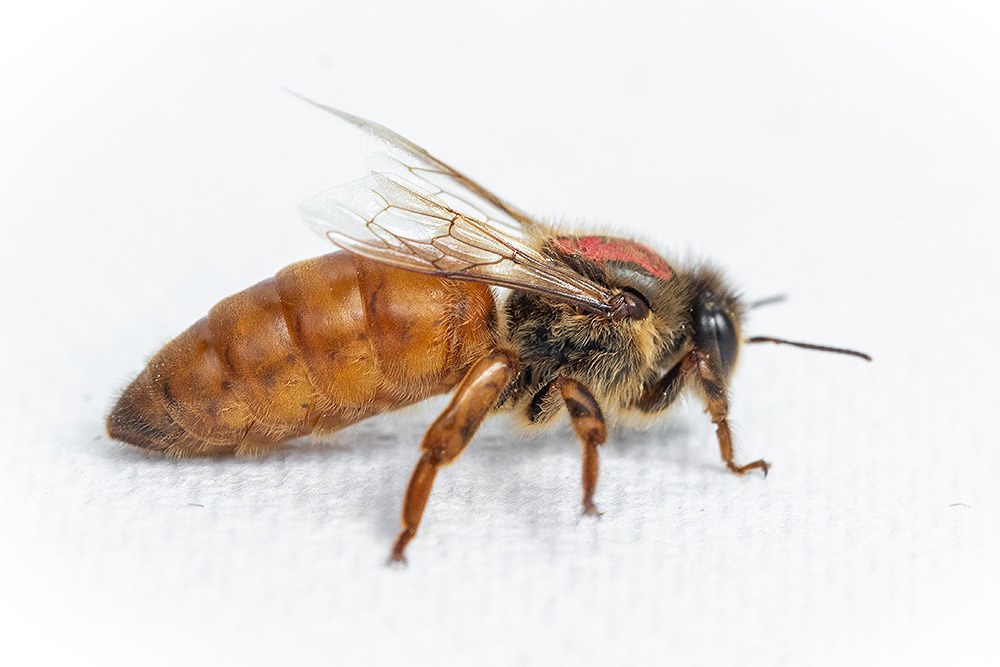Posted: June 23, 2020
Beekeepers are always looking for the best ways to improve the health and productivity of their honey bee colonies.

The queen bee is the most important member of a honey bee colony.
Healthy colonies are only possible if there is a healthy, productive queen bee. The queen is the most important member of a honey bee colony. As the only reproductive female, the colony's success is dependent on her ability to lay thousands of eggs daily. Without a good queen a colony cannot grow and will eventually die. In this Webinar Kate Anton, a research technologist and beekeeper in the Center for Pollinator Research, discusses queen biology and techniques for queen rearing.
Though both queens and workers are female, the biology of queens is very different. After hatching, the female larvae that are chosen to be queens will only be fed royal jelly rather than worker jelly. Royal jelly is a sweet and protein-rich chemical whereas worker jelly is a combination of royal jelly, pollen, and nectar. The royal jelly is produced by the nurse bees. It is crucial that colonies have access to abundant resources to feed nurse bees which in turn feed the developing larvae. Queens also develop faster than the other members of the colony. Queens only take about 16 days to emerge, while workers take about 21 days, and male drones take about 24 days. After the 16th day, a queen will emerge and take care of important tasks before mating. First she will eliminate the competition and complete physical maturity. After that she will fly to a drone congregation area and mate with 12 or more drones. If the queen is successful, egg laying will begin 3-7 days later. During ovary development and the onset of laying, the queen's abdomen enlarges and there will also be changes in the pheromone blend that she produces, which helps organize the social behavior within the colony. Once the queen is consistently laying eggs, the queen is considered a success and the colony can flourish.
Understanding queen biology is critical for beekeepers who want to rear their own queens. Rearing new queens offers beekeepers many benefits such as easy access to replacement queens, increase in colony numbers, more control over genetics, increased colony productivity, and increased self sufficiency. Queen rearing naturally occurs in the colony during times of reproductive swarming (which usually happens in the spring, when the colony is growing rapidly in size), supersedure (which happens when the old queen fails), or if the queen is dead or missing (this is called "emergency" queen rearing). In this Webinar, Anton goes through a few different ways beekeepers can induce these behaviors in order to rear a large number of queens. Queen rearing also requires cell builders -which are colonies that initiate, provide, and care for queen cells. There are many techniques for creating cell builders and beekeepers must find a system that works best for their needs and their environment. Cell builders need to be provided with suitable larvae to rear queens. The most common method of queen cell production is grafting. Grafting is the process of transferring a larva from a brood cell to a manufactured cell cup. Once the queens have been capped they can then be placed in an incubator to complete their development. Queen cells can be placed in colonies, mating nucs or released into colonies as virgin queens.
While rearing queens may take a lot of time and energy, many beekeepers find it fun and rewarding. Rearing your own queens can help create a more self-sufficient and effective apiary. Having access to many young and healthy queens can help to greatly increase colony productivity and the number of colonies. These large colonies can increase pollination and produce excess honey. With a good queen, a colony can meet its full potential. More information about queen biology and queen rearing can be found at PSU extension links listed below!
Written by Ashley Moak
Full webinar descriptions and registration information.
More Information:
- Introduction to queen honey bee development
- Beekeeping call builder basics
- Queen cell production grafting and graft free methods
For additional questions you can contact Kate Anton

